Bruno Ribeiro
MAESTRO
Boosting Relational Deep Learning with Pretrained Tabular Models
Apr 07, 2025Abstract:Relational databases, organized into tables connected by primary-foreign key relationships, are a common format for organizing data. Making predictions on relational data often involves transforming them into a flat tabular format through table joins and feature engineering, which serve as input to tabular methods. However, designing features that fully capture complex relational patterns remains challenging. Graph Neural Networks (GNNs) offer a compelling alternative by inherently modeling these relationships, but their time overhead during inference limits their applicability for real-time scenarios. In this work, we aim to bridge this gap by leveraging existing feature engineering efforts to enhance the efficiency of GNNs in relational databases. Specifically, we use GNNs to capture complex relationships within relational databases, patterns that are difficult to featurize, while employing engineered features to encode temporal information, thereby avoiding the need to retain the entire historical graph and enabling the use of smaller, more efficient graphs. Our \textsc{LightRDL} approach not only improves efficiency, but also outperforms existing models. Experimental results on the RelBench benchmark demonstrate that our framework achieves up to $33\%$ performance improvement and a $526\times$ inference speedup compared to GNNs, making it highly suitable for real-time inference.
TRIX: A More Expressive Model for Zero-shot Domain Transfer in Knowledge Graphs
Feb 26, 2025Abstract:Fully inductive knowledge graph models can be trained on multiple domains and subsequently perform zero-shot knowledge graph completion (KGC) in new unseen domains. This is an important capability towards the goal of having foundation models for knowledge graphs. In this work, we introduce a more expressive and capable fully inductive model, dubbed TRIX, which not only yields strictly more expressive triplet embeddings (head entity, relation, tail entity) compared to state-of-the-art methods, but also introduces a new capability: directly handling both entity and relation prediction tasks in inductive settings. Empirically, we show that TRIX outperforms the state-of-the-art fully inductive models in zero-shot entity and relation predictions in new domains, and outperforms large-context LLMs in out-of-domain predictions. The source code is available at https://github.com/yuchengz99/TRIX.
DiTASK: Multi-Task Fine-Tuning with Diffeomorphic Transformations
Feb 09, 2025Abstract:Pre-trained Vision Transformers now serve as powerful tools for computer vision. Yet, efficiently adapting them for multiple tasks remains a challenge that arises from the need to modify the rich hidden representations encoded by the learned weight matrices, without inducing interference between tasks. Current parameter-efficient methods like LoRA, which apply low-rank updates, force tasks to compete within constrained subspaces, ultimately degrading performance. We introduce DiTASK a novel Diffeomorphic Multi-Task Fine-Tuning approach that maintains pre-trained representations by preserving weight matrix singular vectors, while enabling task-specific adaptations through neural diffeomorphic transformations of the singular values. By following this approach, DiTASK enables both shared and task-specific feature modulations with minimal added parameters. Our theoretical analysis shows that DITASK achieves full-rank updates during optimization, preserving the geometric structure of pre-trained features, and establishing a new paradigm for efficient multi-task learning (MTL). Our experiments on PASCAL MTL and NYUD show that DiTASK achieves state-of-the-art performance across four dense prediction tasks, using 75% fewer parameters than existing methods.
CENSOR: Defense Against Gradient Inversion via Orthogonal Subspace Bayesian Sampling
Jan 27, 2025



Abstract:Federated learning collaboratively trains a neural network on a global server, where each local client receives the current global model weights and sends back parameter updates (gradients) based on its local private data. The process of sending these model updates may leak client's private data information. Existing gradient inversion attacks can exploit this vulnerability to recover private training instances from a client's gradient vectors. Recently, researchers have proposed advanced gradient inversion techniques that existing defenses struggle to handle effectively. In this work, we present a novel defense tailored for large neural network models. Our defense capitalizes on the high dimensionality of the model parameters to perturb gradients within a subspace orthogonal to the original gradient. By leveraging cold posteriors over orthogonal subspaces, our defense implements a refined gradient update mechanism. This enables the selection of an optimal gradient that not only safeguards against gradient inversion attacks but also maintains model utility. We conduct comprehensive experiments across three different datasets and evaluate our defense against various state-of-the-art attacks and defenses. Code is available at https://censor-gradient.github.io.
Scalable Out-of-distribution Robustness in the Presence of Unobserved Confounders
Nov 29, 2024Abstract:We consider the task of out-of-distribution (OOD) generalization, where the distribution shift is due to an unobserved confounder ($Z$) affecting both the covariates ($X$) and the labels ($Y$). In this setting, traditional assumptions of covariate and label shift are unsuitable due to the confounding, which introduces heterogeneity in the predictor, i.e., $\hat{Y} = f_Z(X)$. OOD generalization differs from traditional domain adaptation by not assuming access to the covariate distribution ($X^\text{te}$) of the test samples during training. These conditions create a challenging scenario for OOD robustness: (a) $Z^\text{tr}$ is an unobserved confounder during training, (b) $P^\text{te}{Z} \neq P^\text{tr}{Z}$, (c) $X^\text{te}$ is unavailable during training, and (d) the posterior predictive distribution depends on $P^\text{te}(Z)$, i.e., $\hat{Y} = E_{P^\text{te}(Z)}[f_Z(X)]$. In general, accurate predictions are unattainable in this scenario, and existing literature has proposed complex predictors based on identifiability assumptions that require multiple additional variables. Our work investigates a set of identifiability assumptions that tremendously simplify the predictor, whose resulting elegant simplicity outperforms existing approaches.
Vertical Validation: Evaluating Implicit Generative Models for Graphs on Thin Support Regions
Nov 20, 2024


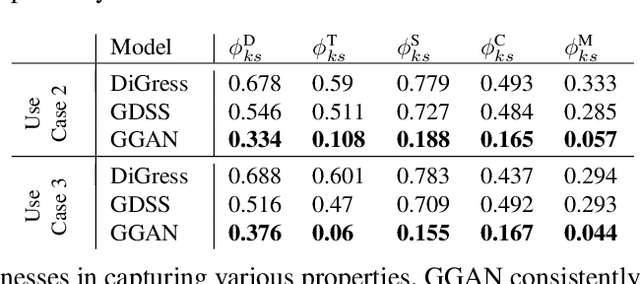
Abstract:There has been a growing excitement that implicit graph generative models could be used to design or discover new molecules for medicine or material design. Because these molecules have not been discovered, they naturally lie in unexplored or scarcely supported regions of the distribution of known molecules. However, prior evaluation methods for implicit graph generative models have focused on validating statistics computed from the thick support (e.g., mean and variance of a graph property). Therefore, there is a mismatch between the goal of generating novel graphs and the evaluation methods. To address this evaluation gap, we design a novel evaluation method called Vertical Validation (VV) that systematically creates thin support regions during the train-test splitting procedure and then reweights generated samples so that they can be compared to the held-out test data. This procedure can be seen as a generalization of the standard train-test procedure except that the splits are dependent on sample features. We demonstrate that our method can be used to perform model selection if performance on thin support regions is the desired goal. As a side benefit, we also show that our approach can better detect overfitting as exemplified by memorization.
DiGRAF: Diffeomorphic Graph-Adaptive Activation Function
Jul 02, 2024



Abstract:In this paper, we propose a novel activation function tailored specifically for graph data in Graph Neural Networks (GNNs). Motivated by the need for graph-adaptive and flexible activation functions, we introduce DiGRAF, leveraging Continuous Piecewise-Affine Based (CPAB) transformations, which we augment with an additional GNN to learn a graph-adaptive diffeomorphic activation function in an end-to-end manner. In addition to its graph-adaptivity and flexibility, DiGRAF also possesses properties that are widely recognized as desirable for activation functions, such as differentiability, boundness within the domain and computational efficiency. We conduct an extensive set of experiments across diverse datasets and tasks, demonstrating a consistent and superior performance of DiGRAF compared to traditional and graph-specific activation functions, highlighting its effectiveness as an activation function for GNNs.
Zero-shot Logical Query Reasoning on any Knowledge Graph
Apr 10, 2024



Abstract:Complex logical query answering (CLQA) in knowledge graphs (KGs) goes beyond simple KG completion and aims at answering compositional queries comprised of multiple projections and logical operations. Existing CLQA methods that learn parameters bound to certain entity or relation vocabularies can only be applied to the graph they are trained on which requires substantial training time before being deployed on a new graph. Here we present UltraQuery, an inductive reasoning model that can zero-shot answer logical queries on any KG. The core idea of UltraQuery is to derive both projections and logical operations as vocabulary-independent functions which generalize to new entities and relations in any KG. With the projection operation initialized from a pre-trained inductive KG reasoning model, UltraQuery can solve CLQA on any KG even if it is only finetuned on a single dataset. Experimenting on 23 datasets, UltraQuery in the zero-shot inference mode shows competitive or better query answering performance than best available baselines and sets a new state of the art on 14 of them.
GraphMETRO: Mitigating Complex Distribution Shifts in GNNs via Mixture of Aligned Experts
Dec 07, 2023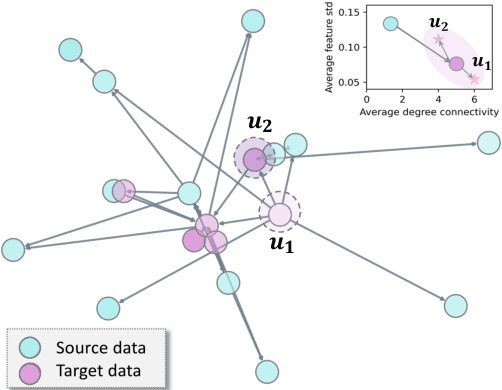
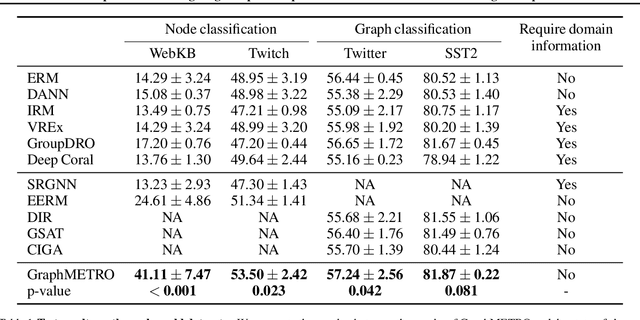
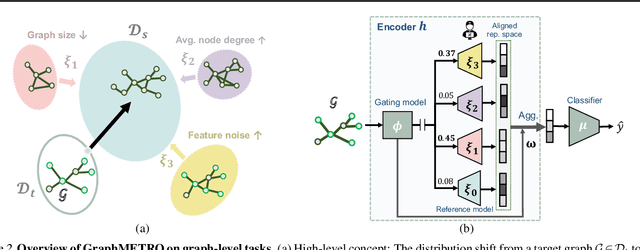
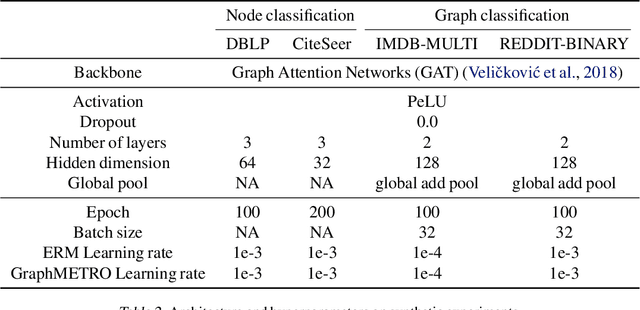
Abstract:Graph Neural Networks' (GNNs) ability to generalize across complex distributions is crucial for real-world applications. However, prior research has primarily focused on specific types of distribution shifts, such as larger graph size, or inferred shifts from constructed data environments, which is highly limited when confronted with multiple and nuanced distribution shifts. For instance, in a social graph, a user node might experience increased interactions and content alterations, while other user nodes encounter distinct shifts. Neglecting such complexities significantly impedes generalization. To address it, we present GraphMETRO, a novel framework that enhances GNN generalization under complex distribution shifts in both node and graph-level tasks. Our approach employs a mixture-of-experts (MoE) architecture with a gating model and expert models aligned in a shared representation space. The gating model identifies key mixture components governing distribution shifts, while each expert generates invariant representations w.r.t. a mixture component. Finally, GraphMETRO aggregates representations from multiple experts to generate the final invariant representation. Our experiments on synthetic and realworld datasets demonstrate GraphMETRO's superiority and interpretability. To highlight, GraphMETRO achieves state-of-the-art performances on four real-world datasets from GOOD benchmark, outperforming the best baselines on WebKB and Twitch datasets by 67% and 4.2%, respectively.
MIST: Defending Against Membership Inference Attacks Through Membership-Invariant Subspace Training
Nov 02, 2023



Abstract:In Member Inference (MI) attacks, the adversary try to determine whether an instance is used to train a machine learning (ML) model. MI attacks are a major privacy concern when using private data to train ML models. Most MI attacks in the literature take advantage of the fact that ML models are trained to fit the training data well, and thus have very low loss on training instances. Most defenses against MI attacks therefore try to make the model fit the training data less well. Doing so, however, generally results in lower accuracy. We observe that training instances have different degrees of vulnerability to MI attacks. Most instances will have low loss even when not included in training. For these instances, the model can fit them well without concerns of MI attacks. An effective defense only needs to (possibly implicitly) identify instances that are vulnerable to MI attacks and avoids overfitting them. A major challenge is how to achieve such an effect in an efficient training process. Leveraging two distinct recent advancements in representation learning: counterfactually-invariant representations and subspace learning methods, we introduce a novel Membership-Invariant Subspace Training (MIST) method to defend against MI attacks. MIST avoids overfitting the vulnerable instances without significant impact on other instances. We have conducted extensive experimental studies, comparing MIST with various other state-of-the-art (SOTA) MI defenses against several SOTA MI attacks. We find that MIST outperforms other defenses while resulting in minimal reduction in testing accuracy.
 Add to Chrome
Add to Chrome Add to Firefox
Add to Firefox Add to Edge
Add to Edge